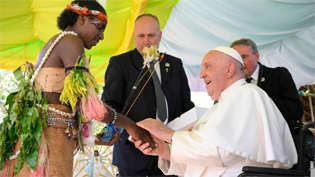Blog
In a wheel chair to the peripheries
First published in Pearls and Irritations, 14 September, 2024
Paul Collins
 Eighty-seven-year-old Pope Francis' trip to Indonesia, Papua-New Guinea, Timor-Leste and Singapore shows he's not slowing up.
Eighty-seven-year-old Pope Francis' trip to Indonesia, Papua-New Guinea, Timor-Leste and Singapore shows he's not slowing up.One thing you can say about Pope Francis is that he walks the walk, even if it’s in a wheelchair. The recent visit to Indonesia illustrates this. Eighty-seven per cent of Indonesia’s population of 283 million is Muslim; 3.1% are Catholics. But here was Francis building bridges with Islamic leaders as he was welcomed to Jakarta’s Istiqlal Mosque by the Grand Imam, Dr. Nasaruddin Umar, himself a leader in interfaith dialogue. Francis has been engaging with Islam ever since his election in 2013.
Pope and Imam also visited the “Tunnel of Friendship,” between Istiqlal Mosque and the nearby Catholic cathedral; the buildings even share parking lots! Of course, this doesn’t mean everything is easy for Catholics and non-Muslims. They often suffer from petty local restrictions and face threats of violence from extremists.
The two leaders signed a Joint Declaration focusing on common values and the promotion of reconciliation in order to “defeat the culture of violence and indifference.” They stressed that the root of all religion is “the thirst for the infinite … [and] for a greater joy and a life stronger than any type of death, which animates the journey of our lives and impels us to step out of ourselves to encounter God.”
However, the thing that impressed ordinary Indonesians was Francis’ simplicity. He travels in a non-bullet-proof Toyota Innova rather than a limousine, with social media commenting on his “cheap watch” and his staying in the Vatican embassy rather than an upmarket hotel.
Flying Garuda, Francis then travelled to Port Moresby to face a very different situation. Papua-New Guinea is 94% Christian and 26% Catholic. Here he was fulfilling another priority of his papacy, visiting the peripheries of Catholicism. For Francis the future isn’t in the developed West, but in the growing churches of Africa, Asia and Oceania and PNG is right out there on the edge.
Here the issues are tribal conflict, often over land ownership, poverty, sorcery, syncretism between Christianity and traditional beliefs, an underlying violence often directed at women and environmental vandalism by loggers and miners.
As if Port Moresby wasn’t peripheral enough, Francis flew to Vanimo on the north-western edge of PNG near the border with Indonesian-controlled West Papua aboard a RAAF C130 Hercules. Founded by Australian missionaries in the early-1950s, Vanimo diocese brought about 20,000 people together in and around the local cathedral. Adorned with a bird of paradise head-dress, Francis called for an end to tribal and gender-based violence.
He also addressed the issue of exploitation of PNG’s resources by foreign companies, saying that the interests of local people must be protected. Extraction must be sustainable and “improve the wellbeing of all, excluding nobody.” Given the impact of illegal logging and mining and the destruction of river systems, often with the collusion of government, he had to say something.
However, in countries like PNG it’s not what Francis says, but what he symbolizes that’s important. What Catholicism does is connect local people with something much larger than themselves, a broader culture that links them to a worldwide reality. It also gives them a sense of being on a bigger stage. As one older woman said after struggling along the Kakoda Trail to Port Moresby to see the pope: “My spirit pushed me on.” Another man with multiple health issues highlighted a personal connection: “This is my father and I want to be healed”.
The papal visit comes in the twilight of Australian missionaries in PNG. The first Catholic missionaries were French and German, but from the early-1930s many Australian priests, sisters, brothers and lay missionaries brough education, health care and welfare to the most isolated regions. Today the majority of the clergy are indigenous, including the Cardinal-Archbishop of Port Moresby, John Ribat, MSC.
Flying on an Air Niugini Boeing 737, Francis left Port Moresby for Timor-Leste. With a population of 1.4 million and a median age of 20, with 40% under the age of 15, Timor-Leste is 95% Catholic and in excess of 600,000 attended the papal Mass outside Dili.
Catholicism’s strength is founded on its support of the people during the Indonesian occupation when upwards of 102,000 people were killed. However, Francis warned clergy that they “should not think of their ministry as bestowing social privilege, acting as leaders who crush others.” He also obliquely acknowledged the sexual abuse perpetrated by Bishop Carlos Belo, Nobel Laureate and a hero of the resistance, who was removed by the Vatican in 2002. Francis spoke of the dignity of young people who had been “violated” and of the need to “prevent every kind of abuse.”
He also emphasized education in a country where 50% are illiterate. A religious sister working in country sees education as a way out of oppression, particularly for young women. “Here, early marriage is very common,” she said. “Girls can marry as soon as they start menstruating, and they can have babies at 15 … They don’t know their rights.” Female education is particularly important in freeing women and limiting population growth.
With oil reserves running out, Timor-Leste faces an uncertain future with an aging leadership. Francis’ visit put the country back on the world stage, encouraged hope and creativity and assured the population that the church is there to stay.
His last stop was Singapore and then back to the Vatican, his longest trip ever to the peripheries.
Care to comment? .